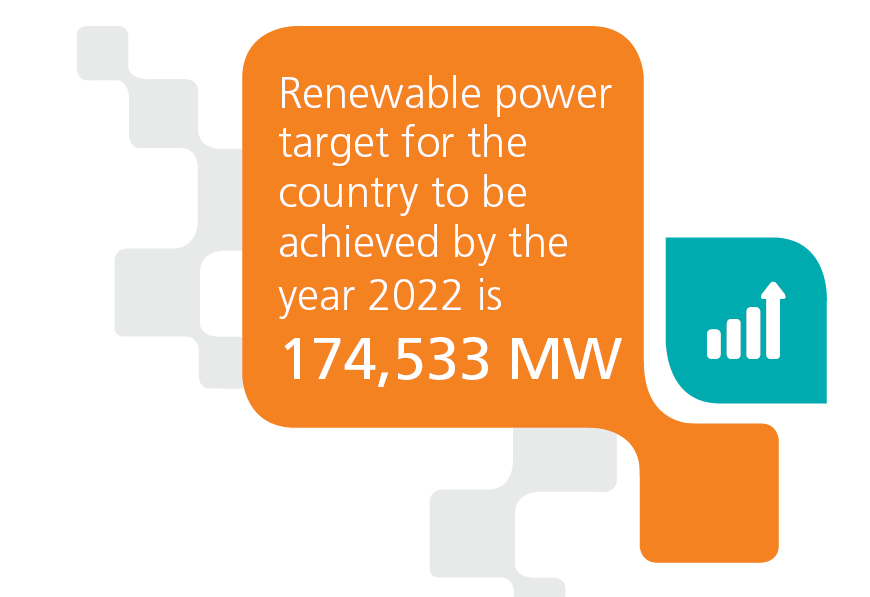Indian Power Industry
Various initiatives have been taken by the Government of India in the areas of coal-mining, renewable-energy, powergeneration and electricity-distribution sectors. After successfully completing the first phase of coal block auctions in FY 15, the Government further increased coal block auctions in FY 16. In the mid and downstream power sector, the Government is strengthening the transmission and sub transmission grids, and also helping States to restructure the debts of the distribution companies. All these initiatives are expected to fuel further investment in the power generation sector. The total installed capacity for power generation in India was 301,965 MW as on 31st March, 2016, and approximately 42,727 MW of the installed capacity was from renewable energy sources.
Industry Analysis
Out of India’s total installed capacity of 42,727 MW of gridconnected
renewable power, a significant share of 63%
came from wind power, while 10% was contributed by small
hydro power. The share of biomass and waste to energy
segments contributed about 12%, with the balance 15%
coming from solar.
The Indian Government has been supporting efforts to meet
the ambitious renewable energy targets in the coming years,
mainly to accomplish the “Power for all” goal and to promote
clean energy. The Ministry of New and Renewable Energy
(MNRE) has been framing policies to attract private investment
in renewable energy through financial incentives to make India
an investment hub for manufacturing and installations.

On a global scale, the share of renewable energy (excluding large hydro) in power generation was estimated at 10.3% in 2015, against 9.1% in 2014. It was estimated that renewable investments in 2015 in developing countries has surpassed the investments in developed countries. The main investors in developing nations include China, India, South Africa, Mexico and Chile. The power generation capacity added in renewable power exceeded the power generation investments in conventional power in 2015. By 2020, it is expected that the amount of global electricity generation coming from renewable energy will be higher than today’s combined electricity demand of China, India and Brazil.
Co-generation
Most of the process industries that require both steam and
power for their processes make dual use of their power
plants. The steam required is produced in the boiler and is
passed through the steam turbine at specific inlet pressure
and temperature. This helps in generating power for the
operation of the facility. The steam at a desired pressure can
be extracted through use of extraction turbines. The steam
thus extracted at a particular pressure and temperature can
be used for process requirements. The steam that is still inside
the turbine further expands and is used for power production.
Thus the requirement of both the steam and power is fulfilled
through a single process. Process co-generation industries
form a major component of the customer segment for Triveni
Turbine Ltd.
There is significant potential of process co-generation in
various industries, such as breweries, caustic soda plants,
textile mills, distilleries, fertiliser plants, paper and pulp industry,
solvent extraction units, rice mills, petrochemical plants, etc.
Furthermore, these co-generation projects also use conventional
fuels, such as coal, oil, lignite, gas etc., for meeting their power
and energy requirements.
Renewable Energy
Biomass-based power generation, waste to energy, waste heat
recovery (excess heat converted to power) form a major part
of TTL’s customer base. The advantages of assured fuel supply,
flexibility to switch fuel sources, and financial incentives make
this segment a steady contributor to meet the growing energy
demand. However, this segment also suffers from supply
constraints due to environmental factors such as drought or
floods. Such was the case during FY 16 in Maharashtra, where
many new biomass-based projects could not operate for desired
periods due to extreme drought.
India’s total estimated biomass power potential is about 25,000
MW. It is estimated that the potential for power generation
from agricultural and agro-industrial residues is about 18,000
MW. With higher steam temperature and pressure, and
efficient project configuration in new sugar mills coupled with
modernisation of existing ones, the potential of surplus power
generation through bagasse co-generation in sugar mills is
estimated at 7,000 MW.
According to the estimates, the renewable power target to
be achieved by India by the year 2022 is 174,533 MW, which
includes 99,533 MW from solar (57%), 60,000 MW from wind
(34%), 10,000 MW from biomass (6%) and 5,000 MW from
small hydro power (3%).
Captive Power Plants
Captive power is the power produced inside the premises of an industry or establishment for self-consumption. Captive power plant is the only economically feasible solution where reliable grid power is not available. India has an installed captive power capacity of 40,726 MW as of September 2015. The Government of India allowed the captive power producers to participate in coal auctions last year to address the problem of coal shortages.

Market Analysis
Domestic Market
Currently, the capital goods industry is rated as an underperformer due to overcapacity and market slowdown in user industries. The industry has been growing at 1% in the last 3 years. However, we expect this industry to grow at the back of strategic Government initiatives such as “Make in India”, new “National Capital Goods Policy” etc. The new “National Capital Goods Policy” addresses major issues such as availability of finance, availability of raw material, innovation and technology, sharing of industry best practices, promoting domestic production from 12% to 20% of total manufacturing activity, and promoting exports. The Government is also supporting this sector by encouraging other allied industries.
Exports Market
The global economy continues to be sluggish. However, on a global scale, there is a drive to increase renewable energy investment. Further, reduction of landfills is also boosting investment in sectors such as biomass and waste to energy. Countries such as the UK, Thailand and South Africa have shown good progress, while Kenya and Colombia are expected to pick up in new renewable energy investment. Global sugar production deficit, coupled with droughts in various regions due to El Niño, and market correction have helped the global sugar prices to increase, which is a positive sign for new investment in the sugar segment.
